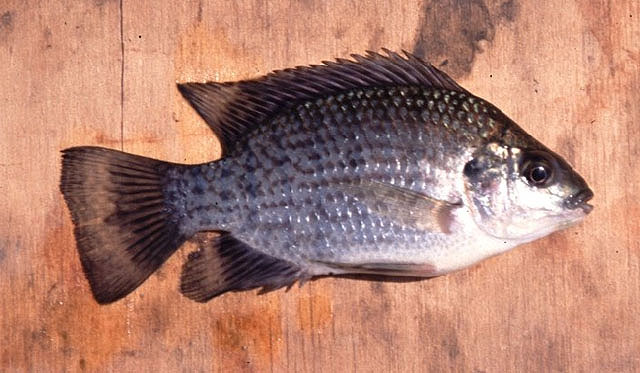| Cichlidae (Cichlids), subfamily: Pseudocrenilabrinae |
| 35.5 cm TL (male/unsexed); max.weight: 1,100.0 g |
|
benthopelagic; freshwater; brackish |
| Africa: Lower Zambezi and southwards in the lower parts of the Sabi, Lundi, Pungwe and Buzi Rivers (Ref. 5166); also Ruvuma River on the Tanzanian-Mozambique border; Lake Rutumba, Lupululu system, and the Lupuledi west of Lindi (Ref. 5166). Previously, two subspecies were recognized: Oreochromis placidus placidus and Oreohromis placidus ruvumae. |
|
Dorsal spines (total): 16-18; Dorsal soft rays (total): 10-13; Anal spines: 3-4; Anal soft rays: 8-11; Vertebrae: 29-31. Description: Deep bodied with straight predorsal profile, mature males with concave profile, extended soft dorsal and anal fins (Ref. 52193). Gill rakers on lower limb of first gill arch 16-20 (Ref. 2, 52193). Dorsal fin with 16-18 spines and 10-13 soft rays; anal fin with 3-4 spines and 8-11 soft rays (Ref. 2, 52193). Lateral line scales 30-32 (Ref. 52193). Colouration: Adults olive brown above, silvery below, with sooty grey head and fins; red margin to dorsal fin (Ref. 52193). Juveniles silvery with 8-9 faint vertical bars; soft dorsal, anal and caudal fins with dark streaks and light spots (Ref. 52193). Breeding males are very dark grey on head and body with throat and all fins black; with a red or orange margin on the dorsal and grey or black marblings on the gill-cover (Ref. 2, 52193). |
| Prefers quiet pools with marginal vegetation; it has been reported only from fresh water and low altitudes and latitudes, so that its salinity and temperature tolerances are probably narrower than those of O. mossambicus (Ref. 2). |
|
Least Concern (LC); Date assessed: 01 May 2018 Ref. (130435)
|
| harmless |
Source and more info: www.fishbase.org. For personal, classroom, and other internal use only. Not for publication.
